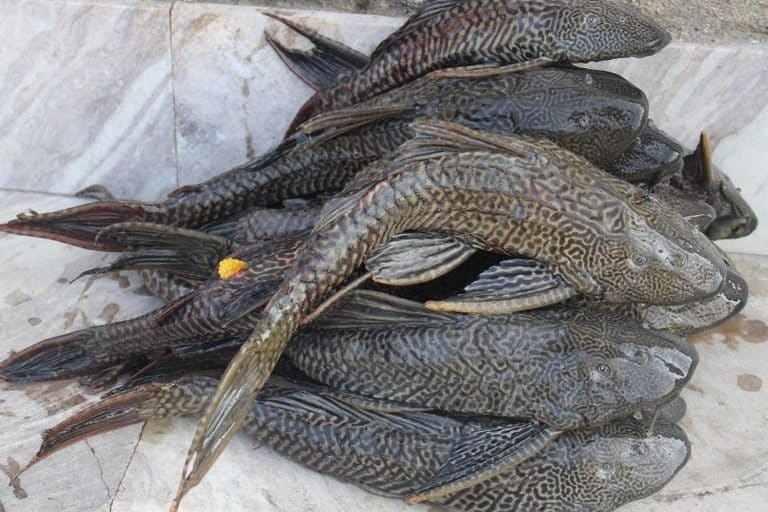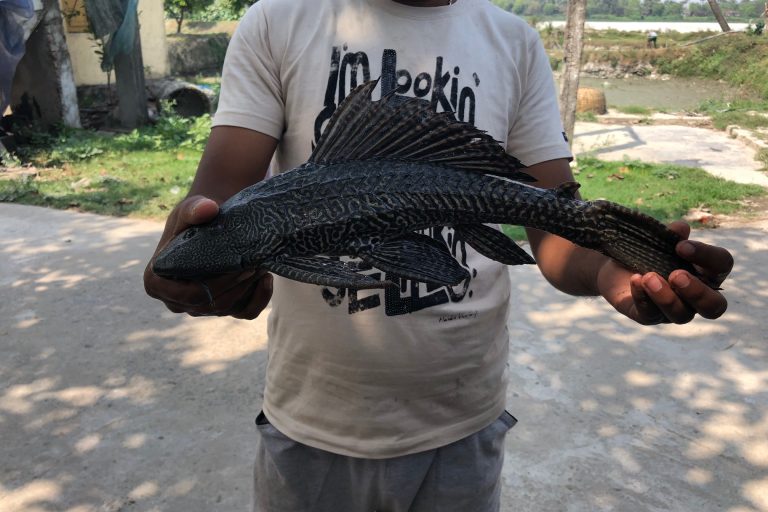- Hardy and popular as aquarium fish, suckermouth sailfin catfish (Pterygoplichthys spp), have silently invaded water bodies in India, threatening ecosystems. Researchers are now exploring eDNA based tools to detect and check its spread in India.
- Environmental DNA (eDNA) is defined as genetic material that is released from an organism into the environment. Sourced from hair, shed skin, faeces or carcasses in water or soil samples, eDNA applications avoid the need to sample the DNA directly from the organism itself.
- There is a need for legislation to prevent the release of ornamental fish and potentially-damaging alien species into natural water bodies.
Suckermouth sailfin catfish (Pterygoplichthys spp.) or ‘janitor fish’ are popular among aquarium owners as hardy and peaceful bottom feeders that keep the tank clean. But these native South American fish, with their distinct armoured plates and markings, are now slowly and silently invading water bodies across India, threatening local species. To detect, track and control the spread of this intrusion, researchers suggest tools based on environmental DNA.
Environmental DNA is an emerging tool that is getting better at reliably pinpointing an organism’s presence simply by analysing the environment itself.
It is essentially the genetic trace an organism leaves behind in the environment (soil, sediment, water, snow) in the form of hair, shed skin, faeces or carcasses. These small amounts of DNA can be used to probe the presence and abundance of organisms in a sample, avoiding the need to get hold of the specimen itself.
The identity of multiple fish species can be detected simultaneously in a small quantity of water. So the eDNA method is highly cost-effective when compared to the labour intensive traditional methods, explained researcher Ratna Ghosal, assistant professor at Division of Biological and Life Sciences, School of Arts & Sciences, Ahmedabad University. She has worked extensively in the field of invasive fish in North American ecosystems.
Incidentally, eDNA analysis was used in North America for the first time in 2009 and 2010 to detect invasive Asian carp in and around the Great Lakes.

“Random sampling is not going to help if there is only one or two individuals in gallons of water. Through eDNA, a cup of water can tell you about the presence of multiple species,” Ghosal told Mongabay-India.
Ghosal is among a group of scientists who is now exploring the idea of applying eDNA to detect non-native suckermouth sailfin catfish invasion in India.
Highly resilient and not fussy about water quality, several non-native armoured catfish species of the genus Pterygoplichthys have surreptitiously encroached upon water bodies from northeast India to Kerala in the south.
All four common species of this genus (Pterygoplichthys pardalis, P. multiradiatus, P. anisisti and P. disjunctivus) have been reported from inland water bodies of the country, informed Ajmal Hussan, scientist at the ICAR-Central Institute of Freshwater Aquaculture at Kalyani in West Bengal.
Invasion by suckermouth sailfin catfish in India. Map developed on Google Maps.
“East Kolkata Wetlands in West Bengal is the only place as of now in India, where these fish have invaded extensively with a self-sustaining population. It is in competition with the commercial carp culture and is affecting the aquaculture scenario of this unique ecosystem. We are currently estimating the economic loss caused by the fish in the wetlands,” Hussan told Mongabay-India.
According to a review article published in Current Science, so far, 27 ornamental species have been reported in the inland wetlands of India. Among them, 15 have already established a good breeding population and have emerged as a threat to the native species. Suckermouth sailfin catfish is one of them, the report states.
Unregulated pet trade primarily contributes to its spread. The secret to their invasive capabilities lies in their ability to withstand poor oxygen content in water, and the presence of bony armor plates and spines that makes them relatively difficult to consume. They are also less vulnerable to predation due to the absence of natural predators in India, according to aquatic diversity expert A. Biju Kumar of University of Kerala.
In Kerala, non-native Pterygoplichthys spp. have been observed to tolerate low levels of salinity for extended periods and can invade brackish-water ecosystems of the state. These data can help predict the invasion success and potential geographic spread of the fish into coastal systems in Kerala and worldwide.
Unchecked, they alter or diminish the food availability for native fish by overgrazing on algae and detritus, destroy submerged aquatic vegetation – the spawning site and refuge of many small indigenous fish – ultimately displacing or reducing the native fish population.

Batting for innovative detection, barrier and management techniques including eDNA analysis, Hussan said the fact that these cryptic herbivores may go undetected for long periods, once introduced into suitable habitat, only adds to the dilemma surrounding surveillance.
Biju Kumar believes that although direct observation is possible, as the fish are large and easy to spot and they frequently come up to the water surface, eDNA assay is the “best option” where sampling is difficult.
Needle in a haystack
Zeroing in on fish in large water bodies, when they occur in low density, is virtually like looking for a needle in a haystack, said Ghosal.
But if fish are “trained”, by using food, to gather at a specific site (where they are otherwise too scarce to be reliably measured) then the eDNA released during such aggregations can be gauged by collecting water samples and performing a DNA assay.
Tapping the idea, Ghosal devised a cost-effective, integrated site-specific approach, based on eDNA and sex pheromones, that lures the target species to a specific location in the water system. Both the biomarkers – sex pheromone and eDNA – are highly species specific and they complement each other.
Pheromones are chemicals released into water by fish and these chemicals are highly species-specific in nature. Fish use pheromones for a variety of functions, including food search, courtship, mating, defense and social aggregation.
eDNA gives information on the species identity and on the abundance/density of the individuals, whereas, sex pheromone provides information on the gender and also confirms the species identity.

The study (in press) was conducted by Ghosal to develop an integrated species-specific approach to effectively detect the presence of the common carp, one of the most invasive fish in the North American ecosystems.
“Using a combination of methods, we could bring the target species to us for sampling instead of finding the target species in large volumes of water. Such methods will lead to improved detection and management regime,” said Ghosal.
Similar work for another species, the invasive silver carp, by Ghosal, has shown that such induced species-specific aggregations can be effectively trapped using traditional netting methods.
“Thus, baiting and use of biomarkers (eDNA and sex pheromones) do induce species-specific aggregations and provide accurate measurements on the aggregations, which can then be targeted for effective removal of the target species,” Ghosal said.
Ghosal suggested the eDNA approach would also work in India where invasive fish is a larger threat to the country.
She plans to collaborate with Hussan and Jitendra Sundaray (ICAR-Central Institute of Freshwater Aquaculture) on the impact of the suckermouth catfish on the native economically important species (Rohu, Catla, Mrigal) and on the native ecosystem (water quality, plankton diversity).
They also seek to develop the eDNA tool for the suckermouth fish and will test the tool for detection of the species in high-and low-density closed water systems within India.
But a fair amount of background work is needed to launch eDNA based approaches.

“You need to know the species to develop genetic markers (targetted DNA) against eDNA. You need to know at what level of water (surface, sub-surface) you need to sample. The physiology and behaviour of fish can be exploited to our benefit, for an effective management of invasive fish,” Ghosal pointed out.
While eDNA decays fast (within six to seven hours of fish presence), in a way it’s advantageous, said Ghosal, as deposition of the genetic material over time will lead to false signals.
Biju Kumar opined that controlling invasive species can be difficult, but the best method to prevent introduction of invasive species is through policy making and education.
“There is an urgent need for a legislation to prevent the release of ornamental fish and potentially damaging cultivable alien species into the natural bodies and to formulate programmes to return the unwanted pets to the aquarium traders as a precautionary principle,” Biju Kumar added.
BANNER IMAGE: Sailfin pleco (Pterygoplichthys gibbiceps) in a fish tank. Photo by Soulkeeper/Wikimedia Commons.
